Film and Medium Specificity: A Voyage to Italy Through France and Russia
Does film, as an art, have a unique and proper area of competence? Is there anything in film we could call “unique in nature”? A difficult argument to make considering how much it owes to the more established arts of painting, photography, poetry, and theater – a more incisive question, perhaps, is whether there can be innovation or significance in an art form constituted almost entirely of other art forms.
To approach an answer to this question we’d do well to consult two of the most notable thinkers on the purpose and power of film: Andre Bazin and Sergei Eisenstein. They occupy places on opposite ends of the critical spectrum when it comes to the cinema, but the implicit conversation of their criticisms – when manipulated into explicit dialogue surrounding one work of filmic art – might reveal some interesting truths about how we judge film specifically, but also art in general.
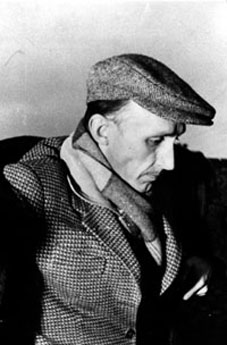
In addition to offering a masterclass in tact, Andre Bazin’s “In Defense of Rossellini” letter to Guido Aristarco provides readers with a characteristically indeterminate sketch of his own cinematic predilections. In the letter, Bazin explains how neorealism differs from the realism that comes before it in that “its realism is not so much concerned with the choice of subject as with a particular way of regarding things” (97). Evidently, a filmmaker like Roberto Rossellini fits snugly within this definition because his films are structured such that the viewer sees “nothing but the event itself,” and is never assaulted with “intended effect” (101, 100).
To be assaulted with an “intended effect” is to watch a film by Sergei Eisenstein: his stated goal with film montage is to exercise “emotional influence over the masses” through “a series of blows to the consciousness and emotions of the audience” (Writings 39). In his conception of montage, something neurological should occur to the audience. He also states, tellingly, in “The Dramaturgy of Film Form,” that he takes cinema – in its mechanistic purposes – to be closer to writing than theater or painting (CV 275). Unlike Bazin, Eisenstein supports cinema’s potential to prompt mental and emotional responses, and this can be achieved through choice juxtapositions of structures and conventions, or as he puts it, “tendentious selection of, and comparison between, events” (Writings 41).
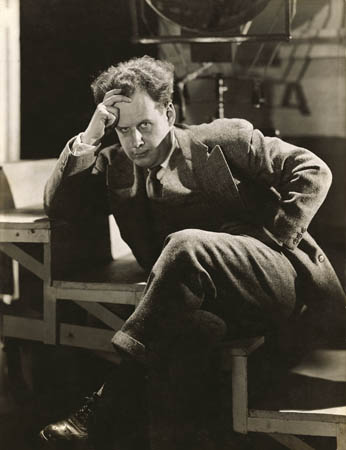
What remains after ridding cinema of this purposeful method of idea association (montage) are merely gestures, changes, physical movements, or as Bazin puts it in his letter, “the essence of human reality” (100). But this idealized view of the neorealist impulses in Rossellini’s films is clouded somewhat when Bazin argues that there is “nothing in [Rossellini’s] films that belongs to literature or to poetry” (100). What then are we to make of Bazin’s discussion of the positives of neorealism in the face of the final paragraph of “The Evolution of the Language of Cinema,” wherein he writes, “[t]oday we can say that at last the director writes in film” (CV 324)?
In comparing the director to the novelist, does Bazin not imbue the film director with an – essentially human – authorial autonomy impossible to distinguish from the “intended effect” of both Eisenstein’s montage and art composed in language? In considering specific moments within Voyage to Italy (Rossellini, 1954), the film Bazin draws so much from in his letter, we can approach an understanding not only of conflicts between Eisenstein’s conception of montage and Bazin’s conception of neorealism, but also of how much within Rossellini’s film – contrary to Bazin’s assertion – belongs to other artistic mediums like literature and poetry. In the end, this particular film assures us that cinema’s expressive power is unleashed through both intra- and inter-medium conversations between supposedly distinct theories and specificities.
As much as Bazin praises the film for its neorealist aesthetic (in particular its treatment of the concluding “miracle”), certain aspects of Voyage to Italy seem to be conscious artistic choices with “intended effect.”
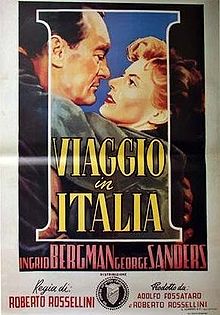
One scene in particular stands out: the tour of Uncle Homer’s home. The scene begins with a long-take, the camera following Alex (George Sanders) and Katherine (Ingrid Bergman) as they are led by Natalie (Natalia Ray) into the front room to the right of the entrance and then back into the foyer and up the stairs. But whereas the camera in this first shot approaches the front room doorway, retreats with a tracking movement as they leave the room, stops briefly to admire a beautiful chest as Katherine does, and then pans to the left to follow their ascent upstairs, subsequent shots in the tour scene are noticeably edited and create a sense of brusqueness for the spectator.
This sense of brusqueness echoes the hurriedness of the tour as well as Katherine’s somewhat flustered and uncomfortable response to the event: the first cut coincides with Tony (Anthony La Penna) and Natalie indistinctly whispering behind Katherine’s back on the stairs; Tony’s quick overview of the landmarks visible from the terrace results in only the briefest of long-shots (presumably Katherine and the others’ view) of each of those natural features before moving on; when Tony remarks on a “quite famous” painting in Homer’s old room he does not wait for Katherine (or the camera) to appreciate it in close-up detail, instead moving swiftly to the window, which Katherine looks out of for perhaps two seconds before being forced to follow the group (the moment passes so quickly that we as spectators are not even shown her view outside the window, notable because we were previously allowed her perspective on the terrace). Whatever the intended effect is, the consistent rapidity of the camera movement over a series of distinct shots invites the viewer to share the same sense of hurriedness Katherine feels during the tour. The scene moves from a Bazin-type long-take to a series of Eisenstein-type quick cuts, and it seems to leave both Katherine and the spectator breathless with exertion.
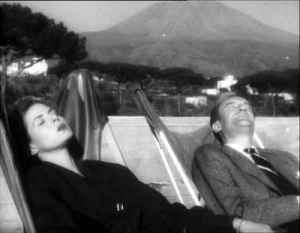
Not only does this particular scene within a neorealist film assault the spectator with “intended effect,” but in nudging the spectator to share Katherine’s disconcertion it also makes the case for creative interventions (like montage) being able to more accurately translate – for the spectator – a character’s “way of regarding things.” Bazin’s definition of neorealism thus appears to have set up a false dichotomy between verisimilitude and artifice – sometimes, in the cinema, to best “see nothing but the event itself” requires bowing to “intended effect.”
Though Bazin champions Voyage to Italy for being distinct from literature and poetry, the film often contradicts his assessment of its medium specificity; in fact, much of the film’s originality and appeal arises from moments that beg comparison to other artistic mediums. From Alex’s uncle’s name, to Alex’s letter about going to Capri appearing as an intertitle might, to Marie (Maria Mauban) and her husband patching their marriage up through letters and his knack with a “phrase,” Rossellini’s film consistently pays homage to the written word. Katherine’s monologues in the car as she drives to historic sites (“He thinks I’m going to give in. […] He’ll see, he’ll see”) even remind one of a Shakespearean work. And of course, the most blatant reference to a non-filmic medium manifests in the form of Charles Lewington and his poetry. Katherine first recites the poem (“temple of the spirit, no longer bodies, but ascetic images, compared to which mere thought seems flesh, heavy, dim”) out loud to Alex, and then we hear her internal intonation during her second historical site visit, an act seemingly prompted by the gruff guide saying the word “lovers.”
But it is the first museum visit that offers the most intriguing case of inter-medium reference, for the camera movements in the scene can be considered a filmic adaptation of the narrative method found in literature and referred to as free-indirect-discourse.
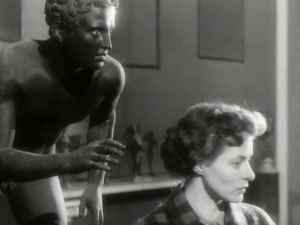
In combining the narratorial commentary of the tour guide with the curious, seemingly un-instigated and always mobile close-ups of the statues, the film stays true to neorealism’s “particular way of regarding things” without blitzing the spectator with unequivocal intentions, for the circling, close-up shots of the statues nearly always begin with a cut directly to the art before panning to Katherine’s face in medium close-up – in this way, the camera’s perusals are accorded to Katherine’s gaze in a narrative grammar distinct from the more widely acknowledged shot/counter-shot. In much the same way as the onset of free-indirect-discourse complicated and progressed literary narrative, this scene propels filmic language forward.
In the following scene, Katherine remembers the poet who prompted her visit to the museum: “Poor Charles, he had his own strange way of seeing things.” Indeed, as exhibited in his poem, Charles’ method of viewing privileges the spirit over the corporeal; likewise, in the presentation of the film itself, the spiritual is privileged over the corporeal, for it is the non-diegetic, eerie sci-fi score that drowns out the noise of the Italian tour guide’s diegetic explanations. Even as it affirms the power of the filmic medium to be imaginative (as it can combine sound and image to express/intensify a work’s thematic strains), Voyage to Italy draws that imaginative power from collation with literature and poetry.
In his postulating cinema’s specificity in relation to other artistic mediums, Bazin wishes, almost zealously, for cinema to prove to him its superiority by downgrading the interventions of humans in favor of cinema’s roots in a pure, human-less, almost mystical process: “All the arts are based on the presence of man, only photography derives an advantage from his absence” (CV, “The Ontology of the Photographic Image” 313). And when he praises neorealism for its ability to get at “the totality in its simplicity,” Bazin praises the progressive film technique while also attesting to something universal, almost god-like in its power to reach an ideal form stripped of “appearances” (“In Defense of Rossellini” 101). But how was photography invented, if not by the labor of those same humans, forever doomed to interact by presenting and interpreting “appearances”?
As much as Bazin hopes for this art’s essential purity of expression, it seems that due to its roots in photography cinema could not avoid the “creative intervention of man” (CV 313). Film seems just as reliant on – and effective or intriguing as a result of – intended effect as artistic mediums like literature and poetry. Why should Bazin rue this, especially given his closing paragraph in “The Evolution of Cinema as a Language”? It is mistaken to deem the cinematic medium any less impressive than other artistic mediums because it does not affect us “like a phenomenon in nature,” for as Voyage to Italy asserts, even the most affected filmic work can be innovative despite using existing literary/poetic approaches and their reliance on both choice and comparison (313).
Works Cited
Bazin, André, and Hugh Gray. What Is Cinema? “In Defense of Rossellini,” Berkeley Univ. of California, 1971. Online.
Eisenstein, Sergei. Writings, 1922-1934: Sergei Eisenstein Selected Works. [S.l.]: I B Taurus, 2010. Online.
Corrigan, Timothy, Patricia White, and Meta Mazaj. Critical Visions in Film Theory: Classic and Contemporary Readings. Boston: Bedford/St. Martin’s, 2011. Print.
What do you think? Leave a comment.











It was great reading your article in its use of film theory. It is intriguing to contextualise different film theories in comparison or contrast to each other, makes for a great read.
For the longest time i though bazin was a director. i knew he had theories on film but i was surprised he wasnt.
Eisenstein is a master of his craft. I have studies much of his work like, October. The most experimental and the montage is insane, technically much better than Potemkin, the story I think was well told also.
And Battleship Potemkin, extremely influential/important but did not care that much for it, and as good as the montage is , I did not find it that impressive for today’s standards, unlike with October.
Last I watched was Old and New, Best cinematography, montage is insanely good again but not as impressive as October… problem is it went on for too long for me and I did not care that much for what was happening.
I saw October just the other day! I was astonished by the cinematography, this would be called a very modern experimental film if it was done today… I knew he had pretty much invented it but I really didn’t expect it to be so good… what he does in October is CRAZY… this man had to be a genius. I didn’t care that much about the rest of the film… but nearly every shot is so good in ‘technique’ to be still really interesting.
Bronenosets Potyomkin!
Great article, spec for us who find film studies interesting!
eisenstein was truly a master filmaker. even though he was a latvian collaborator with the soviet occupiers. that doesn’t diminish the effect of his films. bazin is new to me.
I first crossed paths with Eisenstein’s work in a film class where we learned about the “Eisensteinian Montage.” I was fascinated with this technique from the first time I saw it. It was nice reading your article and learning more about these inspirational legends, nice work!
Andre Bazin is one of three greatest cinema critics.
I’m studying Eisenstein now, and I was never terribly fond of his early montage styles, but his latter films are great. I never understood why The General Line has been marginalized the way it has, but I was blown away.
Sergei Eisenstein is, in my opinion, one of the greatest directors that ever lived. A pure genius.
Definitely theory-heavy in a particular era of film.